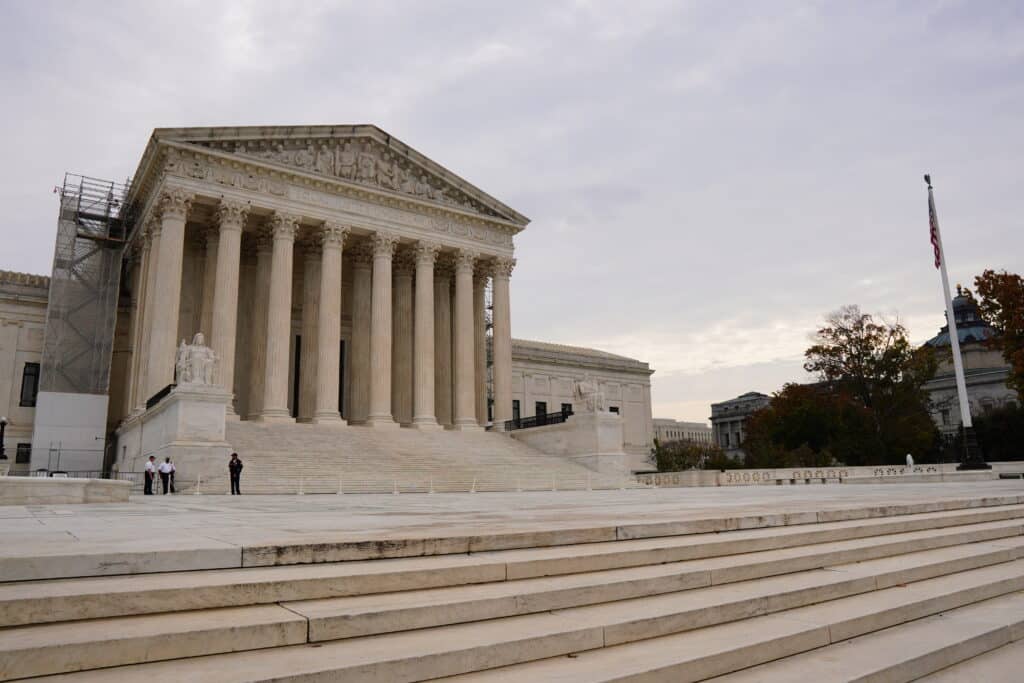Joe Biden and Donald Trump faced off for the first time in what may be the least anticipated rematch of all time. And the result certainly lived up to that billing, with Biden having a particularly disastrous showing. But, more importantly, at least for our purpose, it didn’t touch on gun policy at all.
I explain why that seems a bit strange, even though each candidate’s position on the issue is fairly well established already. They both had something to gain (and lose) by bringing up guns. But neither one did.
Contributing writer Jake Fogleman does a deep dive into Justice Clarence Thomas’s lone dissent in the Supreme Court’s only Second Amendment case this term. What was it that made the author of the Bruen decision argue the majority’s first application of it so disastrous? What did the other justices say in response?
Plus, Tim Mak of The Counteroffensive joins the podcast from Ukraine to talk about a gun-rights push happening there.

Analysis: Candidates Mum on Guns at First Debate [Member Exclusive]
By Stephen Gutowski
The first presidential debate showed Americans a lot about the two men again vieing to run the country, for better or worse. But neither candidate sought to differentiate themselves on gun policy.
That’s a bit surprising since President Joe Biden and former President Donald Trump have cultivated gun positions that are polar opposites. Biden has even made his firearms policies a greater part of his re-election bid in recent months. Meanwhile, Trump leads on the question of who would handle gun policy better and has continued to court gun voters through the NRA.
But neither man attempted to pivot the conversation to guns during the hour-and-a-half debate.
That’s perhaps most surprising for Biden. Though the race has been a toss-up, Democrats have traditionally needed to win by a few points to reach the critical mass required in battleground states to ensure a win. Biden has trailed in the vast majority of battleground polling headed into the debate, which meant he should’ve been on more of an offensive to try and shake the race up a bit.
His stilted performance may indeed have shifted the race, but probably not in his favor since his freezing up and stumbling over answers highlighted one of his biggest vulnerabilities. Despite the renewed focus on gun control in the run-up to the debate, he didn’t bring it up. Biden had been pushing the issue to the forefront of his campaign of late.
He spoke at Everytown’s national conference for the first time in his presidency.
“It’s time to do what I did when I was a Senator, ban assault weapons,” Biden said to chants of “four more years” from the crowd. “I mean it. Who in God’s name needs a magazine that can hold 200 shells?”
His campaign released a gun-control ad.
“When Trump was president— children gunned down in classrooms, innocent people killed in church and massacred at a concert. Still, Trump did nothing,” Biden said in the ad. “He sided with the NRA, but I sided with you. I’ve expanded background checks, created an office of gun violence prevention, and now murder rates are down.”
He and his campaign have tweeted support for new gun restrictions on nearly a daily basis. His Surgeon General also just released a new gun-control push.
It may not rival abortion or democracy as a top-tier issue of his campaign, but Biden has certainly been elevating it lately. That’s likely part of a broader effort to excite Democratic voters, who’ve been lukewarm about giving him a second term to this point. Of course, they’ve also been part of the reason he’s gotten low marks on his handling of gun policy as president.
Biden’s approval on firearm policy has actually been lower than his abysmal general approval rating since he took office. The last time the Associated Press and NORC Center for Public Affairs Research asked about his handling of the issue, Biden clocked in at an all-time low at 31 percent approval. That likely reflects the fact that what he’s been able to accomplish on gun policy, like the pistol brace or “ghost gun” kit administrative bans, fall short of the big-ticket restrictions gun-control advocates want while pissing off many of the gun owners affected by the changes.
The ATF-imposed bans he’s pushed for have been particularly vulnerable to this dynamic.
That approach has left him without strong support from either direction. This is evident in the most recent (pre-debate) Fox News election poll. While Biden was ahead by two points overall, he fell behind Trump on gun policy by the same margin. That was driven by Democrats’ relative lack of support for Biden when compared to how Republicans feel about Trump’s gun policy.
Fox found Republicans were seven points more likely to back Trump’s handling of gun policy than Democrats were to do the same for Biden. Those kinds of numbers are probably why the Biden campaign has tried to emphasize his record on the issue. If they can convince their own voters to come home, it could boost Biden’s overall support.
Of course, that’s a risky approach since some of that opposition is from Democrats who think Biden is too aggressive on the issue.
Minority voters could be especially unhappy with this direction. After all, minorities are the fastest-growing demographic of new gun owners–a trend that has only accelerated since BBiden’s2020 victory. A noticeable slice of the resistance to BBiden’sgun policies inside his own party may come from them, and pushing more restrictions could further alienate them.
Independents are another group that could be turned off by Biden’s approach. Overall, Biden won them by four points in the Fox poll. However, they favored Trump’s handling of guns by two points.
Still, if the Biden Campaign has decided the risks are worth the potential reward, you’d think they’d want to carry that message into what may have been the biggest media event of the campaign. Apparently not, though. Or maybe their candidate wasn’t capable enough to pull off a pivot since guns weren’t directly asked about.
Trump had a less disastrous debate performance than Biden. He was at least somewhat more reserved than he often is at his rallies. But his performance was not exactly good either, and it featured many of the things many Americans have long disliked about him—making wild claims, tossing around insults, and lying about the Capitol Riot.
Trump could have shifted the conversation to guns, too. Like Biden, he had some reason to do so. The Fox poll shows Americans are split but ultimately think he’d be better at handling gun policy. With his overall approval often coming in as down in the dumps as Biden’s, he needs to try and ensure his supporters show up at the polls as well. Gun policy could motivate some of them.
Of course, Trump has his own unique risks in bringing up guns during the debate. It could remind everyone he, the pro-gun candidate, can’t currently own guns because of his felony convictions. In turn, that would put the attention back on his biggest vulnerability.
We’ll have to see what happens in the coming weeks as polls shift in response. As of now, both candidates are still committed to the next debate. If they both end up on stage in September, an increasingly uncertain prospect, perhaps they’ll debate guns then.
Podcast: The Push to Codify Ukrainian Gun Rights (Ft. The Counteroffensive’s Tim Mak) [Member Early Access]
By Stephen Gutowski
This week, we’ve got a guest coming to us straight from the middle of a war zone.
Tim Mak joins the show from Kyiv, Ukraine. He’s an experienced war correspondent who has worked for leading news outlets and founded his own independent publication just over a year ago to cover the war in Ukraine on the ground. The Counteroffensive publishes original reporting from inside the country and recently profiled the man behind an effort to install gun-rights protections in the nation’s law.
Mak said the effort has made significant progress. Legislation to legalize civilian gun ownership has already made it through a first read in the Ukranian parliament. He said it has a lot of support within President Volodymyr Zelenskyy’s party.
Much of that support is driven by Maryan Zablotskiy, who talks a lot like American gun-rights activists and has cultivated relationships inside the American conservative movement. But Mak said he’s not the only one in Ukraine whose opinion on gun ownership has been changed after facing the brutal reality of the Russian invasion. Still, he noted not everyone agrees, and there is an active debate over what regulations on civilian guns should remain.
You can listen to the show on your favorite podcasting app or by clicking here. Video of the episode is available on our YouTube channel. An aut0-generated transcript is here. Reload Members get access on Sunday, as always. The show goes public on Monday.
Click this link for your free trial from our sponsor this week: The Dispatch.
Plus, contributing writer Jake Fogleman and I discuss the lack of discussion on gun policy during the first presidential debate between Donald Trump and Joe Biden. We also cover the ongoing fallout from the Supreme Court’s Rahimi decision, including Justice Thomas’ dissent and the DOJ’s request for more clarity from the Court on gun rights for felons. Finally, we discuss the NRA’s improved political fundraising numbers, its tone shift on gun rights for felons, the ATF’s improved approval times for suppressors, and a Georgia jury’s decision to find gunmaker SIG liable for negligent discharges.

Analysis: What Justice Thomas’s Rahimi Dissent Says About the Bruen Test [Member Exclusive]
By Jake Fogleman
Is the Supreme Court already retreating from its recently adopted Second Amendment legal test? The chief architect of that test seems to think so.
A nearly unanimous Court upheld the federal gun ban for persons subject to domestic violence restraining orders last week in U.S. v. Rahimi. The majority did so after finding that the law fit within the nation’s history and tradition of firearms regulation, the key bar modern regulations must clear to pass constitutional muster under the Bruen standard of review.
“Since the founding, our Nation’s firearm laws have included provisions preventing individuals who threaten physical harm to others from misusing firearms,” Chief Justice John Roberts wrote on behalf of the eight-member majority. “As applied to the facts of this case, Section 922(g)(8) fits comfortably within this tradition.”
Notably, Justice Clarence Thomas broke with his five fellow conservatives as well as the Court’s liberals to register his disagreement. Thomas argued that the Court’s majority failed to adhere to the same Bruen standard many signed on to just two years prior.
“After New York State Rifle & Pistol Assn., Inc. v. Bruen, this Court’s directive was clear: A firearm regulation that falls within the Second Amendment’s plain text is unconstitutional unless it is consistent with the Nation’s historical tradition of firearm regulation,” Thomas wrote. “Not a single historical regulation justifies the statute at issue.”
Specifically, Thomas took issue with what he argued was the majority’s loose interpretation of historical analogues to the modern-day gun ban for persons subject to domestic violence restraining orders.
In upholding the law, Roberts and the rest of the Court acknowledged that a “historical twin” for §922(g)(8) did not exist at the time of the Founding. Instead, they argued that two common public safety measures often employed at the time—surety and affray laws — provide evidence of a more generalized principle of disarming threatening individuals.
Surety laws required those suspected by a justice of the peace of being a public danger, including those possessing firearms, to post a bond against breaching the peace. Meanwhile, affray laws criminalized the act of carrying or using weapons to terrify the public and could be enforced with weapon forfeiture and imprisonment.
“Taken together, the surety and going armed laws confirm what common sense suggests: When an individual poses a clear threat of physical violence to another, the threatening individual may be disarmed,” Roberts wrote. “Section 922(g)(8) is by no means identical to these founding era regimes, but it does not need to be.”
Thomas slammed those comparisons for failing to match “how” and “why” such laws burdened arms rights with the modern restriction, a significant instruction he included in his Bruen opinion for future courts.
“Neither is a compelling historical analogue,” he wrote. “As I have explained, surety laws did not impose a burden comparable to §922(g)(8). And, affray laws had a dissimilar burden and justification. The Court does not reckon with these vital differences, asserting that the disagreement is whether surety and affray laws must be an exact copy of §922(g)(8). But, the historical evidence shows that those laws are worlds—not degrees—apart from §922(g)(8).”
Not only did he fault the offered analogues for falling short individually, but he also chastised the majority for picking specific elements of the two legal regimes to craft a workable tradition in a collage-like approach.
“The Court recognizes that surety and affray laws on their own are not enough. So, it takes pieces from each to stitch together an analogue for §922(g)(8),” Thomas wrote. “Our precedents foreclose that approach. The question before us is whether a single historical law has both a comparable burden and justification as §922(g)(8), not whether several laws can be cobbled together to qualify.”
He even went so far as to charge the majority with “defeat[ing] the purpose of a historical inquiry altogether.”
“Given that imprisonment (which involved disarmament) existed at the founding, the Government can always satisfy this newly minted comparable-burden requirement,” Thomas wrote. “That means the Government need only find a historical law with a comparable justification to validate modern disarmament regimes. As a result, historical laws fining certain behavior could justify completely disarming a person for the same behavior. That is the exact sort of ‘regulatory blank check’ that Bruen warns against and the American people ratified the Second Amendment to preclude.”
Some members of the majority directly addressed Thomas’ critiques. Chief Justice Roberts attempted to rebut his claims that the Court’s opinion failed to provide a relevantly similar historical analogue.
“The dissent reaches a contrary conclusion, primarily on the ground that the historical analogues for Section 922(g)(8) are not sufficiently similar to place that provision in our historical tradition,” Chief Justice Roberts wrote. “The dissent does, however, acknowledge that Section 922(g)(8) is within that tradition when it comes to the ‘why’ of the appropriate inquiry. The objection is to the ‘how.’ For the reasons we have set forth, however, we conclude that Section 922(g)(8) satisfies that part of the inquiry as well.”
He reiterated that Section 922(g)(8) restricts gun use to mitigate demonstrated threats of physical violence, matching the “why” of surety and affray laws. He also noted that sureties were temporary restrictions, much like the modern 922(g)(8) prohibition is, and that affray violations were punished with imprisonment, a far more serious “how” than temporary disarmament.
“If imprisonment was permissible to respond to the use of guns to threaten the physical safety of others, then the lesser restriction of temporary disarmament that Section 922(g)(8) imposes is also permissible,” he said.
Some, like Justice Amy Coney Barrett, addressed Thomas’ view in principle if not in name. She argued that construing Bruen’s historical test to demand “overly specific analogues” poses “serious problems.”
“It forces 21st-century regulations to follow late-18th-century policy choices, giving us ‘a law trapped in amber,’” she wrote. “And it assumes that founding-era legislatures maximally exercised their power to regulate, thereby adopting a ‘use it or lose it’ view of legislative authority. Such assumptions are flawed, and originalism does not require them.”
Meanwhile, the Court’s liberals used the opportunity to respond to Thomas’ dissent by reiterating their displeasure with the Bruen decision overall. Justice Sonia Sotomayor penned a concurrence, joined by Justice Kagan, asserting that she still believes Bruen was “wrongly decided” but that the majority appropriately applied it, rejecting Thomas’ “rigid approach to [its] historical inquiry.”
“The dissent reaches a different conclusion by applying the strictest possible interpretation of Bruen. It picks off the Government’s historical sources one by one, viewing any basis for distinction as fatal,” she wrote. “If the dissent’s interpretation of Bruen were the law, then Bruen really would be the ‘one-way ratchet’ that I and the other dissenters in that case feared, ‘disqualify[ing] virtually any representative historical analogue and mak[ing] it nearly impossible to sustain common-sense regulations necessary to our Nation’s safety and security.’”
With Thomas’ opinion facing opposition from all sides, it can be easy to interpret the result in Rahimi as the Court hastily trying to distance itself from Bruen. After all, the man who articulated the test it established seems to think it has already been diluted. However, the opinion offered some clues for why that might not necessarily be the case.
Putting the liberals aside, all of whom opposed the Bruen test from the start, every conservative Justice aside from Alito wrote separately to emphasize their commitment to relying on history to inform their modern understanding of the Second Amendment. Justice Brett Kavanaugh, for instance, reaffirmed his strong preference for using the Constitution’s text informed by history to govern the Court’s Second Amendment jurisprudence over the interest-balancing approach the Bruen test supplanted.
“Absent precedent, there are really only two potential answers to the question of how to determine exceptions to broadly worded constitutional rights: history or policy,” Kavanaugh wrote in a solo concurrence. “History, not policy, is the proper guide.”
Justice Neil Gorsuch offered similar remarks, acknowledging his disagreement with Thomas’ analysis but reaffirming his commitment to Bruen‘s history-based test.
“If reasonable minds can disagree whether §922(g)(8) is analogous to past practices originally understood to fall outside the Second Amendment’s scope, we at least agree that is the only proper question a court may ask,” he wrote in his own solo concurrence. “Discerning what the original meaning of the Constitution requires in this or that case may sometimes be difficult. Asking that question, however, at least keeps judges in their proper lane, seeking to honor the supreme law the people have ordained rather than substituting our will for theirs.”
Therefore, it is more than likely that the ideological split between Thomas and his fellow Bruen-approving conservatives is a quarrel over a narrow application of its test to a particularly odious defendant rather than a breakdown in support over the test. The majority (as well as Justice Gorsuch’s concurrence) even went to great pains to try to cabin its holding to just the set of facts implicating Zackey Rahimi, so much so that the DOJ has already asked the Court to provide more clarity on who can be disarmed going forward.
Of course, much will depend on how the Court continues to superintend Bruen‘s future applications in lower courts to determine if Justice Thomas’s warnings are prescient and that there truly has been a significant departure from Bruen‘s rigor. But unless the Supreme Court plans to allow lower courts to play fast and loose with Founding-era analogies over the longer term, Thomas’s concerns may not come to fruition.
That’s it for now.
I’ll talk to you all again soon.
Thanks,
Stephen Gutowski
Founder
The Reload






